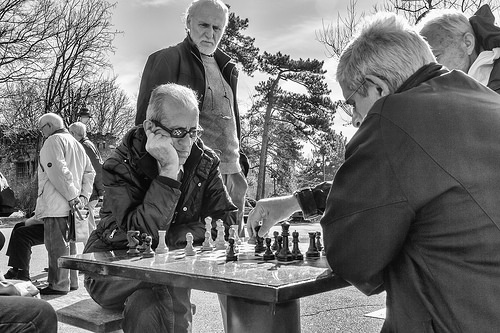I’ve been working through a video series by John Bartholomew called Chess Cognition. This series consists of short clips where John goes through parts of games he has played against national and international masters. He analyzes the games, talks through his thought processes, and emphasizes important learning points from each game.
I’ve been trying to train my thought processes by watching/learning from John. I call this learning “thought process boot camp” because it’s hard work! Even though I’ve learned some of the basic principles of chess, every game is unique and there are so many options/possibilities in every position. It’s boot camp because chess makes my brain sweat.

Learning from Chess Cognition Videos
There were 9 videos in this series. I’ll just embed the ones I found the most helpful here.
The main thing I learned from this video was that undefended pieces (pieces that can be captured by your opponent without any opportunity for you to recapture) are magnets for tactics (short sequences of moves that involve an attack/capture). This was helpful for me as I am working on always keeping my pieces defended; however, I often slip up and leaving pieces hanging and then my opponent is able to use tactics against me.
This video shows John’s opponent missing the best move because he assumed he should immediately recapture. The takeaway here is that moves that may seem good can actually backfire if you calculate further on. This one is important for me because I really struggle with calculating more than 3-4 moves ahead. There are just so many options! I find it difficult to predict how my opponent will respond to my moves, so lines I calculate in my head often work out differently when I go to play them out.
This video was full of new lessons for me! The first was that the number one rule of rook endings is to activate your rook (makes sense). John emphasized the need to play aggressively by finding counterattacks rather than trying to defend in positions like this. He also showed that when advancing pawns it’s best to keep them connected and move them in unison. Promoting passed pawns is definitely a skill I need to work on.
What I liked about these videos:
- The videos are short and interactive.
I’m still working on building my chess attention span, so I like that these videos are only 5-15 minutes long. I also like that he asks the viewer to pause the video and try to find the best move. It’s helpful to compare my thought process to his as he talks through positions.
- Watching is easier than reading.
I find it much easier to follow “chess talk” when I can watch the pieces move. He uses arrows and moves the pieces through multiple lines while he explains, which is super helpful. I sometimes struggle to follow the written portions of the mini chess lessons I do because I have to think really hard about notation in order to understand what they are talking about.
- He talks through his thought processes.
He’ll say things like “I looked at this line first but rejected it because it was too simple and white had a defense against it.” Hearing these thoughts helps me figure out what I should be thinking as I play my own games.
- The videos are based on real games he played.
He usually starts off by identifying when, where, and against whom he played each game. He also doesn’t win all the games, which is encouraging for me to see that even IMs make mistakes.
- The videos are connected.
I watched the videos in order from 1-9, which was beneficial because they started a bit easier and got more challenging. Also, he makes connections between the videos and pulls ideas together to reinforce important concepts.
What I didn’t like about these videos:
- These videos were above my level.
When John gives time to pause the video and find the best move, I would try to calculate but my ideas were often far off or I just wasn’t able to calculate far enough to come to the ideas that he was looking for. Although this was a bit frustrating, I think it was still good for me to hear the tips and to figure out what I should be thinking.
- He does a lot of recapping.
Sometimes his recaps are helpful in reinforcing concepts but at times, I found them repetitive.
Some things I need to work on:
- Thinking about the purpose behind each of my moves
- Keeping my pieces protected
- Promoting passed pawns
I’m excited because I found a new video from John that I think is more at my level! It’s called Climbing the Rating Ladder (up to 1000). It’s an hour long video of John playing a bunch of games against lower-rated players and discussing his thought processes as he plays. I only watched about 5 minutes so far, but the positions already look very similar to what I see in the games I play, so I’m hoping this video will be more applicable and helpful!
